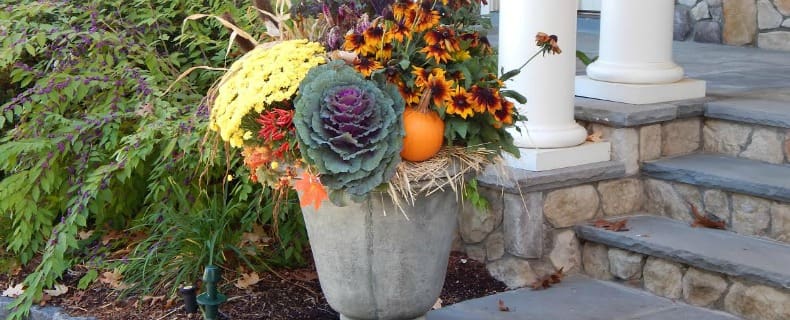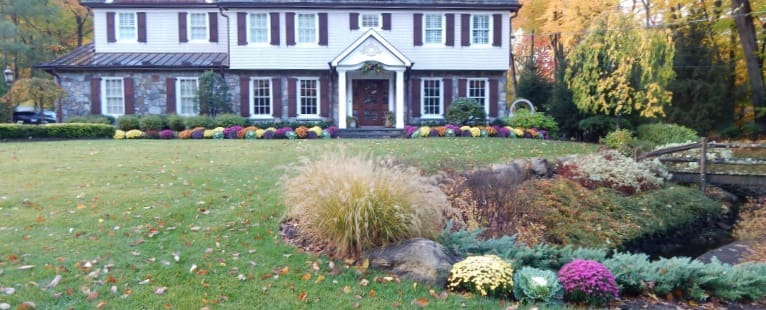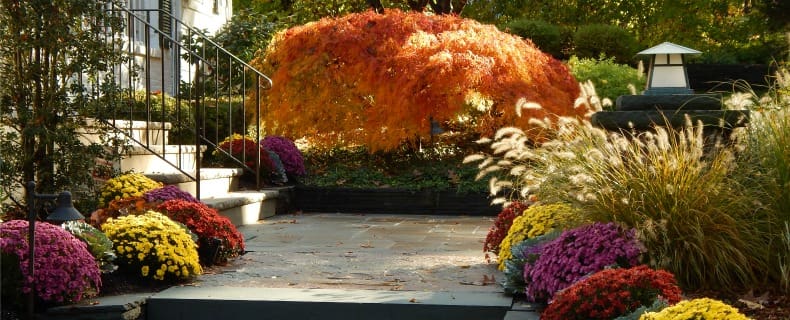As cooler fall weather approaches and leaves change their colors, Bergen County landscapes are filled with beautiful, warm hues of gold, orange and red. Although plant growth begins to slow down and prepare for winter, fall is a great time to concentrate on landscape and design ideas for your home.
A garden landscape filled with brilliant fall colors, interesting textures and fragrant scents will add instant curb appeal and picturesque beauty to any home. With creative planning and the right landscape and design tips, you can create a stunning landscape for the fall season.
 Plant Evergreens
Plant Evergreens
Evergreens are great plants for Bergen County landscapes. They thrive year-round in Northern New Jersey climate and weather conditions, especially during the fall and winter seasons.
Evergreens can create year-round privacy for your yard and provide a beautiful backdrop for other shrubs, trees, plants and flowers that show off brilliant fall colors.
By planting evergreens, you can create landscape borders, private garden areas and interesting garden pathways throughout your landscape.
Evergreens come in a wide variety of plant selections that will add visual interest, scale, texture and color to your landscape. When choosing plants, make sure you select varieties that mature at an appropriate size for your yard.
If you have a smaller yard, a compact Austrian pine only grows to about 15 feet tall and 8 feet wide, while a fernspray false cypress only grows to about 10 feet tall and 4 feet wide. Both varieties work well for small areas and provide privacy without taking up your entire yard.
When selecting evergreens, here are some landscape and design tips:
- Choose Different Varieties – Evergreens develop different shapes as they grow. Some varieties grow in narrow, upright shapes, while others produce mounded shapes. Some evergreens, like the Japanese maple, produce graceful weeping shapes with glorious fall gold and red colors. By combining evergreens with different growth patterns, you will create more visual interest in your landscape.
- Choose Different Colors – To add visual interest and more color to your fall landscape, choose evergreens in a variety of colors. By combining evergreen varieties like the blue-green pine, silvery-blue spruce and dark green arborvitae, you will create depth and interesting layers to your landscape.
- Repeat Plant Shapes – Repeating evergreen shapes throughout your landscape will help to create a sense of unity, structure, formality and visual appeal. If you plant a blue spruce or white pine in your back yard, don’t plant just one. By planting others nearby that repeat the shapes, your landscape and design plan will feel more structured.
Plant Perennials
Perennials, unlike annuals, return to your garden every year with proper care. They bloom, die back, become dormant, then bloom again during the following growth season.
Perennials usually live for several seasons , and there’s a wide variety of perennials that will provide fall blooms for your garden landscape year after year. By planting perennials in the fall, you can freshen up your garden landscape and enjoy color throughout fall and early winter.
Bergen County falls in USDA hardiness planting Zone 6, and there’s a variety of hardy perennials that will thrive in this planting zone and produce wonderful fall colors for your landscape.
- Mums – Mums are a favorite fall perennial because they are easy to grow, and they produce blooms in great fall colors like yellow, orange, red, bronze and burgundy. When buying mums, look for hardy mums, rather that florist mums. Hardy or garden mums are perennials, but florist mums are not.
- Asters – Asters, another fall perennial favorite, come in both compact and taller varieties. Their blooms are usually in the white, pink, lavender and blue color range, so they provide cool color tones as a contrast to your fall landscape and design palette. Plant them where they will get adequate sunlight and air movement to prevent powdery mildew on damp foliage.
- Sedums – Fall-blooming sedums are great perennials for your garden landscape. They are heat and drought tolerant and grow well in poor soils. Sedums begin to bloom in late summer, but bloom well into the fall with brilliantly colored flowers in white, pink, lavender, red and burgundy.
 Transplant Perennials
Transplant Perennials
Most perennials are hardy landscape and design plants. They can be moved easily, but should be moved in the fall when the weather is cool.
If you can choose a time when it’s damp and a little rainy, that’s even better. Plants don’t use as much water in cool weather, so you are less likely to damage the root system.
It’s not a good idea to transplant a perennial while it’s still blooming. If you have plants that are late fall bloomers, wait and move them in the spring.
When transplanting perennials, here are some helpful tips:
- Cut back the tops of plants
- Add 3-inches to 4-inches of mulch around plants to hold in moisture and warm the soil
- Transplant perennials at least 3 to 4 weeks before frost
- Allow time for roots to establish in their new location
- Wait until spring to fertilize transplants
When you dig up your perennials, be careful not to damage the root systems. Dig carefully to loosen soil, then lift plants out of the ground with dirt still on the roots if possible.
If root systems are damaged, the plants will have a hard time absorbing water and nutrients, especially during hot spring and summer months.
If your perennials don’t get enough water and food all year, they may not bloom again when the next fall season rolls around.
Build an Outdoor Spa
As a landscape and design feature, an outdoor spa can add years of relaxing enjoyment and therapeutic health benefits for your family.
What could be better on a cool fall evening than a warm dip in an outdoor spa? An in-ground spa can be used year-round, even in the midst of a snowy Bergen County winter.
- Gunite Spas – A gunite spa is just like a pool but smaller. You can install a gunite spa all by itself or integrate it into a larger swimming pool, so the two can share heating and filtration systems. This spa is typically the most expensive type to build and heat, but it offers unlimited options for size, shape and detailing.
- Fiberglass Spas – Fiberglass spas are usually installed at grade, like gunite spas, but they are less expensive. Fiberglass spas have smooth inner surfaces that are easy to clean, and they come in different shapes, sizes, colors, with special features and jet options. A fiberglass spa is often set into a deck or custom surround, so it looks like an in-ground spa.
An outdoor spa can be integrated into a large swimming pool and used to create water features where the two bodies of water connect.
In sleek, modern style pools, the dividing wall between the pool and spa is often invisible. The wall that separates the spa from the pool, tops out just millimeters below the surface of the pool water, so there’s no visible difference between the two.
 Build an Outdoor Fire Pit
Build an Outdoor Fire Pit
Early fall is a great time to include an outdoor fire pit in your backyard landscape and design plans. An outdoor fire pit is easier, faster and less expensive to build than an outdoor fireplace.
A fire pit is basically installed by digging a hole in the ground, then adding raised walls. The interior of the fire pit that contains the fire (like a fireplace firebox) must be authentic firebrick with fireproof grout for safety.
Although most fire pits are built in a round shape, they can also be square, rectangular or oval. The raised walls are usually covered on the outside with stone, brick, tile or concrete, and they often have a ledge or seating area build around the opening.
Since a fire pit has no chimney and no code restrictions, it can be installed almost anywhere on your property. It’s much smaller and lower to the ground than an outdoor fireplace.
A custom-built fire pit can be designed and built to any width and depth, but there are basic guidelines for height. If you want just want to put your feet up on the fire pit ledge, your fire pit should be 12 to 14 inches high. If you want to sit on the ledge, a height of 18 to 20 inches is best.
Since fire pits are low to the ground and don’t obstruct your landscape view, you don’t need to worry about balancing the size of your fire pit to the size of your back yard. Just choose a comfortable, convenient location, some comfortable chairs and enjoy cozy warmth on a brisk fall night.
At Borst Landscape & Design, we can build a variety of great outdoor features for your Bergen County home. Contact us about our custom landscape and design services.

 Transplant Perennials
Transplant Perennials Build an Outdoor Fire Pit
Build an Outdoor Fire Pit